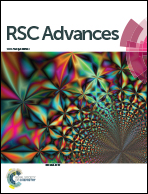Highly selective fluorimetric sensor for Cu2+ and Hg2+ using a benzothiazole-based receptor in semi-aqueous media and molecular docking studies†
Abstract
A new chemosensor (Z)-ethyl 2-((Z)-2-(benzo[d]thiazol-2-ylimino)-4-oxo-3-phenylthiazolidin-5-ylidene)acetate (receptor 1) was designed and synthesized under catalyst-free conditions. Receptor 1 was characterized by various spectroscopic techniques and its structure was solved by single-crystal X-ray diffraction. Receptor 1 was shown to be based on an internal charge transfer mechanism with the benzothiazole unit. These results were complemented by density functional theory calculations. The fluorescent emission of receptor 1 in CH3OH/H2O (50 : 50 v/v) was significantly quenched in the presence of Cu2+ and Hg2+, but not in the presence of other tested metal ions. Receptor 1 formed complexes in a 1 : 1 stoichiometry with Cu2+ and Hg2+ and the detection limits were 0.36 and 2.49 μM, respectively. In addition to the sensing study, the nature of the interactions of 1 with aldose reductase inhibitor was investigated using molecular docking studies.


 Please wait while we load your content...
Please wait while we load your content...